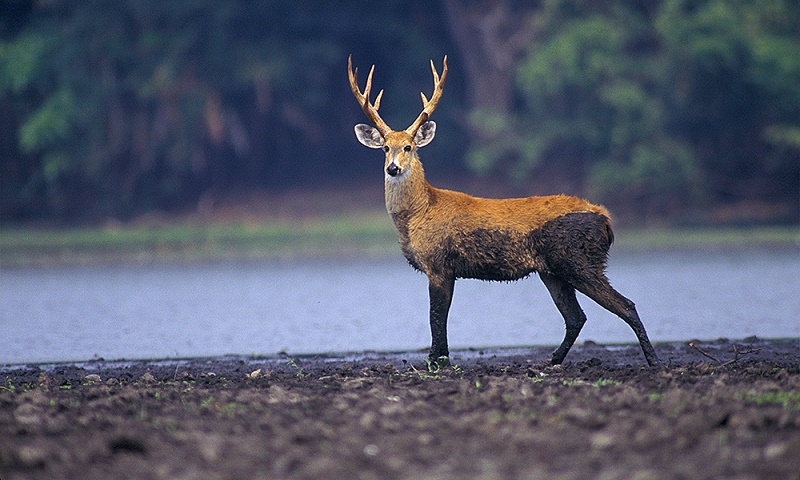The uncontrolled growth of the deer population is causing a crisis on the small island of Anma, South Korea, where the number of these animals has surged to alarming levels, transforming them into a serious threat to local residents.
During the day, Anma appears to be a tranquil place, with its quaint houses nestled between mountainous peaks and a rugged coastline. However, as night falls, the peace of the island is abruptly disrupted. Herds of deer invade the area, causing significant destruction by ravaging crops and damaging trees during their nocturnal wanderings.
The island’s inhabitants, facing a massive invasion, report a desperate situation: there are seven deer for every person. This population imbalance has forced residents to confine themselves behind fences and makeshift barriers, limiting their activities to the interior of their homes and fields. The struggle to keep the deer at bay has proven fruitless, leading many residents to conclude that the only viable solution is to consider culling the herd as a means of restoring balance and protecting their livelihoods.

“I regret to say this, but at this point, we need to get rid of them, which is our intention, even if it means killing them,” said Jang Jin-young, 43, one of the village leaders.
Jang explained that despite South Korean laws prohibiting such measures, the government is considering a petition from island residents to reclassify the deer as “harmful wildlife” rather than livestock. If the petition is accepted, it would allow methods such as hunting to control the population and reduce the damage caused by the deer.
Deer were introduced to Anma Island around 1985 when three farmers brought approximately ten animals with the intention of harvesting their antlers. These antlers, which shed annually, are highly valued in traditional Korean medicine. They are often combined with ginseng and other medicinal herbs, boiled to produce a traditional remedy whose value increases with the quality and quantity of antler slices present in the brew.
However, interest in these medicines began to decline rapidly after the mid-1980s, leading the antler market to dry up. With no demand, the breeders abandoned the deer and left the island.
Without control, the deer population grew unchecked, resulting in a numerical explosion. Currently, it is estimated that about a thousand deer roam an area slightly larger than Central Park in Manhattan. These animals have become a constant threat to the island’s residents, destroying crops and causing widespread damage.
“I can’t take it anymore. I would be happy if someone could please take them away,” lamented Han Jeong-rye, 80, who works in a garden surrounded by a 1.8-meter-high mesh fence. Unfortunately, the fence does not pose a barrier for the deer, who can jump over it or tear it down to devour all the crops.
Kang Dae-rin, who runs a deer farm and markets antlers near the capital, Seoul, has made several visits to Anma to assess the island’s potential as a source of antlers.
During his visits, Kang discovered that the deer on the island were severely infested with ticks, which seriously complicates the transport of the animals and their antlers. He also found that attempting to sedate the deer was a futile strategy.
“It’s impossible to capture them with anesthesia. The deer have already developed immunity, and they can simply all run away,” Kang explained. The situation makes capturing the deer extremely challenging, further complicating any attempt to control their population or recover antlers for sale.
Faced with this scenario, the community of Anma is grappling with a growing dilemma. The population explosion of deer continues to threaten the residents’ livelihood and quality of life, while attempts at effective solutions remain stalled. Without a viable plan to address the infestation and damage caused by the deer, the island and its inhabitants remain at the mercy of an environmental and economic crisis that only worsens over time.
Deer are mammals of the Cervidae family, known for their distinct characteristics and wide global distribution. With over 50 species, these animals inhabit a variety of environments, from forests and mountains to meadows and dense vegetation areas. Among the most well-known species are the red deer, elk, sika deer, and mule deer.
One of the most remarkable features of deer is their antlers, which are branched bone structures found only in males. These antlers are renewed annually; they shed at the end of the mating season and regrow in spring. Antlers are used in dominance and mating disputes. The size variation in deer is notable: while the elk can reach over 2 meters in height at the shoulder, the pygmy deer is significantly smaller.
Deer are herbivores with a diet consisting mainly of leaves, shoots, tree bark, and fruits. Their dietary preferences may vary with the season and food availability. Many species live in social groups, with females often forming herds, while males may be solitary or form temporary groups during the mating season.
Ecologically, deer play an important role in seed dispersal and vegetation maintenance, influencing the structure of plant communities. However, in some regions, deer overpopulation—often caused by the lack of natural predators and habitat reduction—can lead to significant crop damage and negative ecological impacts. This phenomenon can create a cycle of resource competition and trigger environmental imbalances.
Economically, deer are hunted for their meat, hides, and antlers. Antlers, in particular, are valued in traditional medicine, especially in Asia, where they are used to prepare remedies. However, sustainable management is crucial to avoid overloading ecosystems and ensuring that deer populations remain balanced. In some areas, management programs and hunting regulations are implemented to control deer populations and protect the environment.
Thus, deer are fascinating animals that have a significant impact on both the environment and the economy. Understanding their biology and behavior is essential for their conservation and responsible management.

